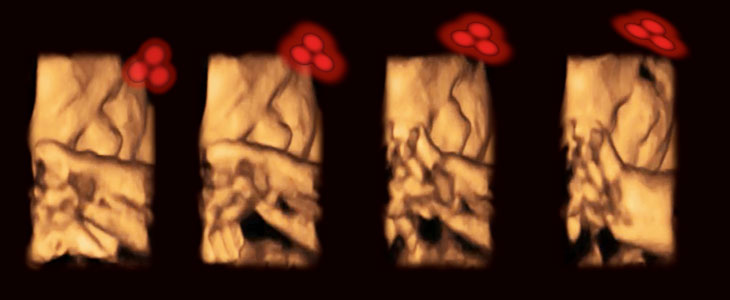For humans, the appeal of looking at faces starts before birth
Experiment is the first to test visual perception in fetuses

FACIAL FIXATION For the first time, scientists have peered inside the womb to watch how fetuses react to the sight of different images.
SciePro/Science Source
- More than 2 years ago
Fascination with faces is nature, not nurture, suggests a new study of third-trimester fetuses.
Scientists have long known that babies like looking at faces more than other objects. But research published online June 8 in Current Biology offers evidence that this preference develops before birth. In the first-ever study of prenatal visual perception, fetuses were more likely to move their heads to track facelike configurations of light projected into the womb than nonfacelike shapes.
Past research has shown that newborns pay special attention to faces, even if a “face” is stripped down to its bare essentials — for instance, a triangle of three dots: two up top for eyes, one below for a mouth or nose. This preoccupation with faces is considered crucial to social development.
“The basic tendency to pick out a face as being different from other things in your environment, and then to actually look at it, is the first step to learning who the important people are in your world,” says Scott Johnson, a developmental psychologist at UCLA who was not involved in the study.
Using a 4-D ultrasound, the researchers watched how 34-week-old fetuses reacted to seeing facelike triangles compared with seeing triangles with one dot above and two below. They projected triangles of red light in both configurations through a mother’s abdomen into the fetus’s peripheral vision. Then, they slid the light across the mom’s belly, away from the fetus’s line of sight, to see if it would turn its head to continue looking at the image.
Story continues below image
Follow that face
These 4-D ultrasound pictures show that projecting a triangle of red dots (top right of each image) into the peripheral vision of a third-trimester fetus and then sliding the dots out of sight caused the fetus to turns its head to track the “face.”

The researchers showed 39 fetuses each type of triangle five times. Of the 195 times a facelike triangle was projected, fetuses turned their heads 40 times. In contrast, the nonfacelike triangles elicited only 14 head turns, says study coauthor Vincent Reid of Lancaster University in England. The finding suggests that fetuses share newborns’ predisposition for looking at facelike shapes, the researchers conclude.
Psychologist Melanie Spence of the University of Texas at Dallas, who was not involved in the work, says it’s a leap to draw too many similarities between the visual perceptions of fetuses and newborns. Although the triangle images mimic facelike ones used to test newborns, they aren’t the same, she notes. Scientists typically show babies faces in black and white, with head-shaped borders.
Still, Johnson says evidence that a fundamental aspect of facial perception may be hardwired into humans’ visual system is “very, very exciting.” The new study’s method of projecting images into the womb and watching the fetus’s reaction also “opens up all kinds of new doors to understand human development,” Johnson says. A similar light projection and 4-D ultrasound technique might be used to see whether fetuses can distinguish between different quantities in the same way that babies can.







